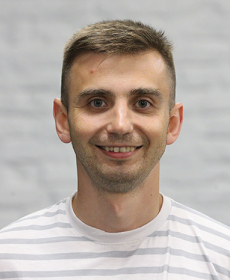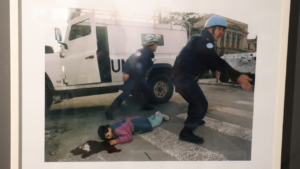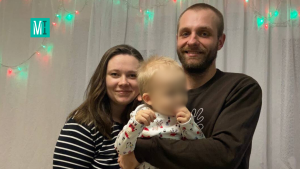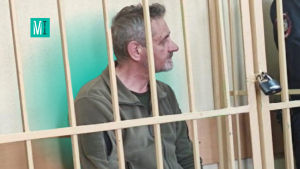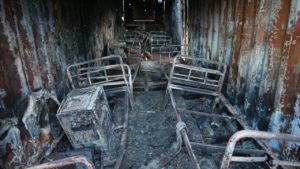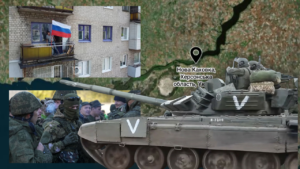Beryslav “prison.” Russians held a teacher captive, urging him to cooperate
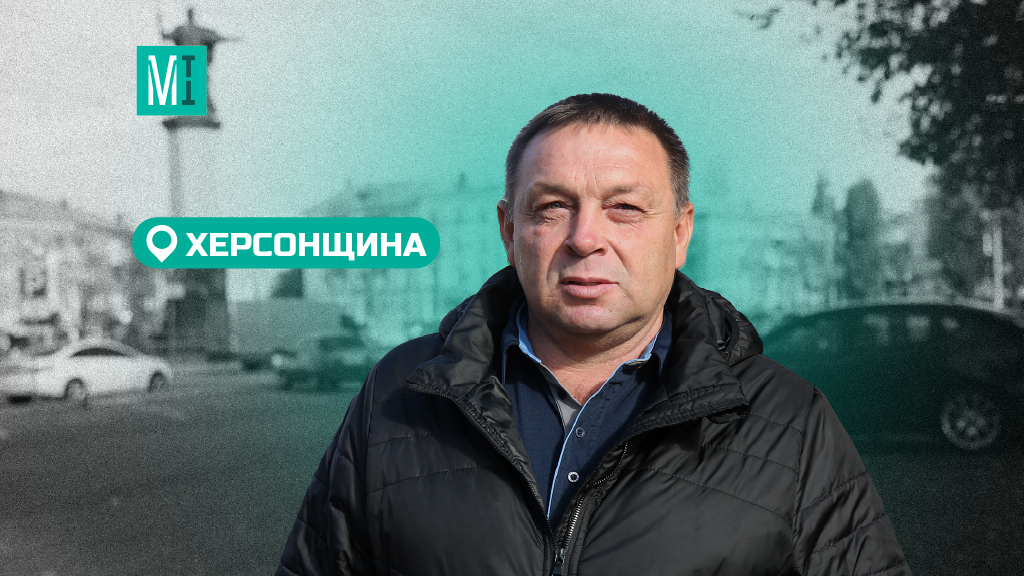
Beryslav is a town in Kherson Oblast that was under Russian occupation from the early days of the full-scale invasion until November 11 this year. It is located on the right bank of the Dnipro. Since the Russians left and got a foothold of the left bank, the town regularly comes under fire.
Serhii Nosach is a local teacher who taught Defense of Ukraine at a Beryslav school. After the town was liberated, he has been there twice to see the ruins of his own house and carpet bombing by the Russians.
He says his schoolchildren are like his own. He recalls drills, competitions, and patriotic camps he would organize for them. His graduates now include dozens of service members and law enforcement officers.
Until August this year, Nosach stayed in his hometown, living under occupation. In the small town of Beryslav, almost everyone knew the teacher and his patriotic views. So, what happened to him on August 5 was hardly a surprise, Serhii admits.
A glow in the sky and an empty town
“On the morning of February 24, I woke up, and my wife was already at the doorstep. She went outside to see what was happening. We saw a glow in the sky. There is a military unit nearby, in Nova Kakhovka. We realized those were some explosions. So, I told my wife: ‘It must be war,’” this is how Serhii recalls the first day of the full-scale Russian invasion.
This is when the first missiles flew over his house towards Kherson, and many policemen gathered in central Beryslav. “I stocked up, went to the gas station. While going back, I see there is no one in town anymore. Around 1 PM, Beryslav looked deserted.”
Nosach’s house is near an intersection, with one road taking you to Velyka Oleksandrivka, and the other to Novovorontsovka. Two huge columns of Russian troops went in these directions on March 9. Serhii watched them from a window in his house.

Serhii saw columns of Russian vehicles in plain sight. Photo by Viktor Kovalchuk/MIHR
“Tanks, Grad MLRS, APCs were on the move. I’m a little tech-savvy. Initially, you could hardly see any IFVs. They started showing up later. Military tent trucks (probably with military personnel inside. — MIHR) were also on their way,” says Serhii. “Of course, I tried to report this… I have Defense of Ukraine peers in Velyka Oleksandrivka. So I warned them that the Russians were coming their way.”
School did not close
The so-called “DNR” forces were housed on the outskirts of Beryslav. They wore respective chevrons on their uniforms. Then they started seizing cars from locals. At first, they drove cars, followed by minibuses.
Their base was in the industrial zone of the former Beryslav PMK [Mobile Mechanical Department], at our athletic complex and the machine-building plant. Then people started going missing in the town.
There were no police in Beryslav, so Serhii Nosach and other men split it into neighborhoods and took turns to prevent looting. Each shift lasted from 8 pm to 6 am.
In April, shortly after the town’s occupation, the Russians went around residents looking for ATO members, collecting weapons from hunters. Another beat was held two weeks later.
“They were mostly from Dagestan. I can tell them by how they communicate. I served in Kaunas, there were Dagestanis in our military unit. On one occasion, right after the occupation took hold, I saw a soldier walking without a mask and asked him, ‘Where are you from?’ — ‘From Russia.’ — ‘And more specifically?’ — ‘I am Chechen.’ — ‘No, you can’t be Chechen if you speak like this.’ — ‘From Dagestan.’ — ‘This sounds more like the truth.’”
Until May, Serhii’s school ran online, studies never stopped. The teacher kept teaching the Defense of Ukraine course even under the Russian occupation.

“Our school was open, we had to keep on teaching our children,” says Serhii. Photo by Viktor Kovalchuk/MIHR
In the next school year, the Russians were planning to have children taught under the Russian curriculum. The existing principal did not agree.
“Our principal helped people, set up a facility at the school where people going to the controlled territory of Ukraine from Kherson and other cities could stay. They spent the night in the gym, school rooms. The principal arranged for the meals. People would even stay for 7 or 8 days at a time,” says Serhii.
Later, in August, the Russians would introduce their own principal.
Detained to get “cooperation”
“On August 5, I woke up and looked out the window to see Ural, UAZ, and SUV driving up to my house. They spit out 10 or 12 Russians. They went into my kitchen, asked my last name, started asking about everything and nothing in particular. Like I later gathered, their objective was to haul me in. ‘If you cooperate, we can talk.’ So, I say: ‘And do you mean by cooperation?’ They never answered,” Serhii recalls that day.
The Russians took a towel from his wife and blindfolded the man.
Serhii could see one soldier better than others. He was the oldest, up to 185 cm tall, Slavic appearance. He could be the commander, because he gave orders.
The Russians who broke into the Nosaches’ house had Kalashnikov assault rifles, machine guns, and pistols. They were in combat mode with safety off.
Serhii’s and his wife’s phones were checked to find a photo of a Butterfly Mine. “What it this?” they ask. Serhii answers: “Well, I’m a teacher. I tell the kids about danger.”
They also found photos of some school graduates in military uniform.
After a 20-minute talk, Serhii was taken blindfolded to an unknown destination in a military Ural vehicle.
“They drove me around the town, looking for someone, and then transferred me to a UAZ,” the man recalls.
Our first stop was on the outskirts of Beryslav, where Russian riot police were stationed. Once the blindfold was removed, Serhii saw their chevrons. Some time later, the UAZ returned.
“I was blindfolded again and questioned in the vehicle. I tell them I am not used to talking to people with my eyes closed, I have to see who I am speaking to. Then they laughed and said: ‘It will be long before you see anything again.’”
In the afternoon, the kidnapped teacher was brought to the machine-building plant. The only place where the blindfold was allowed to be removed was an on-site wooden pit latrine. By peeking through its cracks, Serhii recognized the place where he was.
Container used as a prison cell
When the man was being brought to the plant, shelling began. He was taken to a basement where Russians were also taking cover. Later, one of them ordered: “Take him to the container.”
The construction container found on the site was used instead of a prison cell. It is an iron structure with a wooden floor. Inside, Serhii had an idea of how he could measure its area by using the distance between the top of his index finger and the top of his thumb as a unit of measurement.

This is how Serhii established the area of the container. Photo by Viktor Kovalchuk/MIHR
He found that that container was about 2.2 m wide and 6 to 7 m long. Serhii shared it with 16 other people. When somebody came, those sitting next to the door had to rise. There was a small table with some bottles near it in the corner. They were used as a toilet. Bottles with drinking water were there, too.
In the evening, the Russians came to count the detainees. Later they brought some food. “It was a plastic container with food and three spoons. They usually gave us pasta and some stew. Bread was only given once during all the days,” says Serhii.
Under August sun, the iron container heated up to high temperatures—it was extremely hot inside.
Almost half of those held in the container were former ATO members.
“There were 7 or 8 of them,” says Serhii. “They were from Tiahynka and Tamaryne villages. One was from Beryslav. They were 22 to 30 years old. One guy was collared because his wife left for Ivano-Frankivsk. They ask, “Why do you call her?” He says, “I ask her how she is doing.” They again, “You’re sharing information.”
Serhii also recalls another prisoner’s story. He was detained because they found a friend’s text message on his phone reading “Let’s roast the orcs [Russians].” The guy was brutally tortured, taken to the cemetery, and threatened to be shot.
The first interrogation: allegations of cooperation with the Ukrainian Armed Forces
The day that Serhii was brought to the plant, he was taken for questioning. He was led to a room near the container where the prisoners were kept. There were three Russians in the room, one asking questions, and the other two brutally beating him.
“They found a thread in my phone where I describe convoys going towards Oleksandrivka. They say: ‘Aha, you share our troops’ locations with the Ukrainian army,’” says Serhii.
They started beating him all over his body. The man was blindfolded and had his hands tied behind his back. Electric shock torture was also used.

Torture of kidnapped people, according to Serhii, should have been a case for cooperation with the Russians. Photo by Viktor Kovalchuk/MIHR
Serhii does not know how long it lasted. “Time stops there. When taking me back, one of them said, ‘You won’t live to see the morning.’ And, in general, their words could be trusted, because the night is coming, and who knows what they will do to you. They say, ‘And we will give you and your wife to Kadyrov’s men so you find out what they are like.’”
The second interrogation: threats of shooting
The next day, a Russian who took part in his beating came to pick up Serhii. The teacher recognized his voice.
“When taking me there, he said, “Now you go to the trench, where I’ll shoot you.’ I hear him cock the hammer… This was the morning of my second day.”
Serhii was led through the same winding corridors as the first time. So, he assumed, the room was the same, just like interrogation methods.
“He spoke about my messages again, saying I had shared intelligence. This was followed by electrodes to my little fingers and the electric shock,” recalls Serhii.
The Russians kind of did it automatically,” the man says. Several detainees were brought daily into the interrogation room. Those staying in the container could hear their screams of pain—it was about forty steps to the place of torture.
There were almost no traces of the beating because, as Serhii puts it, they were beaten professionally. Only one boy came from an interrogation with a broken nose. He said that he had knocked something when he was being taken out.
When the interrogation was over, people were taken back to the container.
The third interrogation: shouts that “Putin is the president of the world”
“I will never forget that voice,” Serhii says about the soldier who would take him for questioning. On the third day, he came to pick him up again. They started talking about work suggesting that he work at school under the Russian curriculum.
“I refused and got hit on my body for that,” says the teacher.
The one who beat and put the wires on Serhii’s hands was a tall man of powerful build: “You fall straight to the floor from pain when he punches.”
In addition to talks about cooperation, one could hear other things from the Russians. “One of them would shout that Putin is the president of the world. I thought then that these people were sick weirdos.”

Even a healthy person had a hard time enduring torture and mental pressure. Serhii had a heart condition. Photo by Viktor Kovalchuk/MIHR
After another round of electric shock torture, Serhii began to have heart problems. Even before his capture, he was in a cardiology health center several times and had to take medicine regularly, but the Russians took it away after his arrest.
“Now that they didn’t want to call a doctor, I asked for the pills at least. Then they untied me and gave me the drugs,” says Serhii.
Later, when in the container, he was visited by a man who introduced himself as a medical assistant. He only had Corvalol.
The fourth interrogation: talking about history
On the fourth day, Serhii was taken to another room. That was the first time he was questioned without a blindfold. There was one military man of small stature in the room. He hid his face behind a balaclava. He was sitting at the table, writing.
“He asked me about people who I knew had a pro-Ukrainian position in Beryslav: ‘Where’s this one now, and where’s that one?’ says Serhii. “So, I tell him, ‘They are no longer there, they’ve been in the [Ukraine-]controlled territory for a long time.’ And he goes, ‘You haven’t sold me anyone in three days.’”
They started talking about history. The interrogator tried to convince Serhii that Russia rightfully started the war against Ukraine and that the Ukrainian territory historically belongs to the Russian Federation. “He talked heaps of nonsense, juggling historic facts,” the teacher notes.
At one point, the military man said, “I’m going to the administration. When I get back, we’ll talk again, and I’ll let you go home.” This is when Serhii felt hope for liberation for the first time throughout his captivity.
Release: Getting dropped off in the middle of the city
“On the fifth day, my interrogator entered the container, kicked me, and said, “Come on out.” I got out, they blindfolded me and put me in a car,” the man recalls his path to freedom.
A few minutes later, he was dropped off in the middle of Beryslav. Once the blindfold was removed, Mr. Nosach saw the green SUV that they brought him in. By that time, there were four people left in the construction container, which became a “prison” for civilians.
The teacher owes his release to his wife and mother, who never stopped fighting for him by going to the “commandant’s office” and the newly created “militia,” demanding her husband’s release from illegal imprisonment.
Right after his release, Serhii went to the hospital for heart treatment. Later, he decided to leave Beryslav. During interrogations, he was told, “Don’t even think of leaving, you’re banned from travel. We’ll send word around to all checkpoints.”
“Emotions ran high when I saw our boys,” says Serhii. “There were tears in my eyes.”

His joy of meeting with the Ukrainian armed forces, Serhii says, cannot be expressed in words. Photo by Viktor Kovalchuk/MIHR
Eventually, the teacher was able to leave for the territory controlled by Ukraine, and the Armed Forces of Ukraine liberated his native Beryslav from the occupation a month later.
With no notification of detention
Maria Kvitsynska, Regional Consultant, Europe and Central Asia, Program of the World Organization Against Torture (OMCT), says that the military may only detain civilians in two cases during an armed conflict: if it is absolutely necessary for the security of the detaining state, or if the person has committed a criminal offense, such as murder.
“However, firstly, detention should be based on an official decision of an authorized body. Secondly, detainees must be held in appropriate conditions and guaranteed procedural rights, including the right to appeal and regular review of the interim measures, freedom from torture and other cruel and inhumane treatment and punishment. Thirdly, relatives should be informed about the fact and venue of, and grounds for, the person’s detention,” says Maria.
She further adds that detainees’ details should be entered in relevant registers. Instead, the Russian military arbitrarily detains or abducts civilians deemed by it potentially disloyal. As Serhii Nosach’s story shows, civilians are kept in complete isolation in terrible conditions and tortured.
“The Russian military deliberately withholds information from the detainees’ relatives, causing great suffering to the latter, which in certain cases can be equated to torture. This is a ‘classic’ example of gross violations of international humanitarian law,” adds Maria Kvitsynska.
She urges victims of torture to contact human rights organizations so that they can refer their cases to international accountability bodies for torture crimes.



